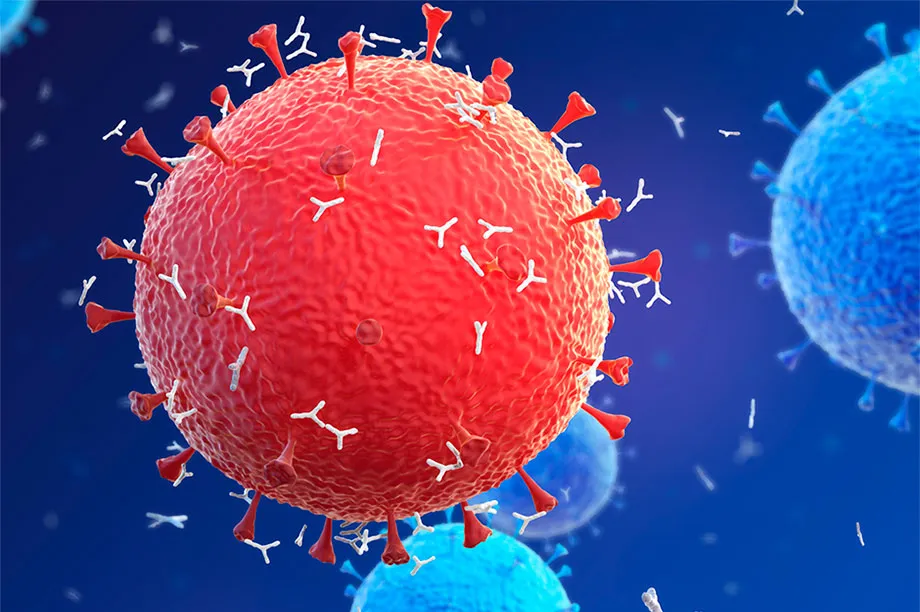The immune response to coronavirus may last for two months after diagnosis, new research suggests.
Results from an antibody testing study have revealed that COVID-19 antibodies remain stable in the blood of the majority of infected people almost two months after diagnosis, and possibly longer.
The study also found that antibodies were not detectable in everyone exposed to the virus, leading to questions about how best to interpret antibody viral tests.
Antibodies are produced by the immune system when it is being attacked in order to destroy substances which carry disease.
Read more about coronavirus immunity:
- Coronavirus antibody tests: How they work and when we'll have them
- Coronavirus vaccine: trial shows drug 'trains immune system' against COVID-19
Researchers say their findings give answers to questions around how long people may remain immune after exposure to COVID-19.
The study was led by researchers and clinicians at St George’s, University of London and St George’s University Hospitals NHS Foundation Trust in collaboration with colleagues at the Liverpool School of Tropical Medicine, Mologic Ltd and Institut Pasteur de Dakar, Senegal.It analysed antibody test results from 177 individuals diagnosed with COVID-19 infection from a viral test.
The pre-print study, which has not been peer-reviewed, measured the levels of antibodies in patients exposed to coronavirus.It found that in those patients with an antibody response, the levels remained stable for the duration of the study – almost two months.
Our results provide an improved understanding of how best to use viral and antibody tests for coronavirus, especially when not every person exposed to the virus will have a positive response
Professor Sanjeev Krishna
The study also found that patients with the most severe infections and largest inflammatory response were likely to develop more antibodies. This may be due to antibody responses working in parallel with an inflammatory response to severe disease, or that a higher viral load could lead to greater stimulation of the inflammatory and antibody development pathways, researchers suggest.
They add that further mechanistic work is required to understand if and why this may be the case.
In the study, between 2 and 8.5 per cent of patients did not develop COVID-19 antibodies at all. The researchers say this may be because the immune response in these patients could be through other immune response mechanisms, such as different antigens or T-cells.
Another option could be that relatively mild infections may be restricted to particular locations in the body where antibody responses are instead dominated by a secretory immune system.

Professor Sanjeev Krishna, corresponding author on the paper from St George’s, University of London, said: “Our results provide an improved understanding of how best to use viral and antibody tests for coronavirus, especially when not every person exposed to the virus will have a positive response.
“We need to understand how best to interpret the results from these tests to control the spread of the virus, as well as identifying those who may be immune to the disease.
“With the number of infections in the UK going down, we now have the very welcome challenge of attempting to carry out more tests to understand whether other factors are associated with an immune response, such as viral load and genetic factors.
“We hope that by sharing our data at an early stage, this will accelerate progress towards effective use of test results around the world.”
Read more coronavirus news:
- Coronavirus: Mandatory face masks 'could save up to 50,000 lives'
- Face mask use needed to ‘prevent COVID-19 second wave’
The study also explored associations between different characteristics and antibody responses.
Being of non-white ethnicity was associated with a higher antibody response, tying into the knowledge that patients from BAME backgrounds are more likely to develop severe disease.
Older patients and those with other conditions, such as with hypertension and being overweight were also more likely to have an antibody response.
What is viral load and why is it important to coronavirus?
Viral load is simply the amount of virus in the body. This varies in different parts of the body, and can change over time. Recent studies have shown, for example, that the viral load in the lungs of COVID-19 patients is greater than that in the nose.
A patient’s viral load increases as the virus replicates and disease symptoms get worse, and then decreases as the patient recovers. So monitoring the viral load can give us a useful indication of how a patient’s infection is progressing.
The amount of virus that you’re exposed to at the beginning of an infection is something different, and this is called the ‘infectious dose’. Studies on other viruses such as the flu and SARS have shown that the higher the infectious dose (the more virus you breathe in), the greater your chances of having more severe symptoms.
With one small exposure, your immune system may be able to fight off the virus before you get sick, but with repeated small exposures (such as touching your face throughout the day) or one large exposure (an infected person coughing in your face), the virus may grow faster than your body can control.
We don’t yet know if this link between infectious dose and disease severity holds for COVID-19, but it may do, and that’s why it’s so important to maintain physical distancing and keep the initial exposure as low as possible.
Read more: